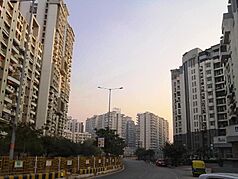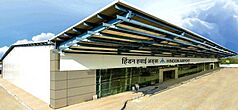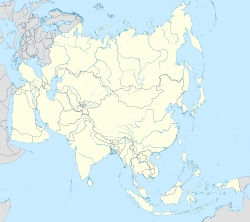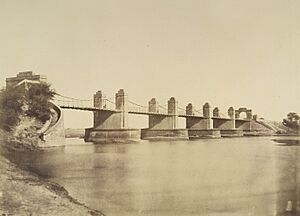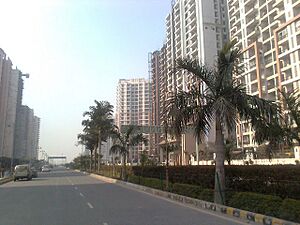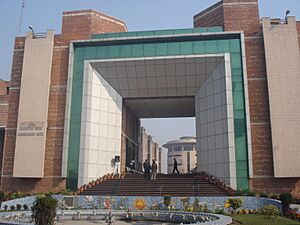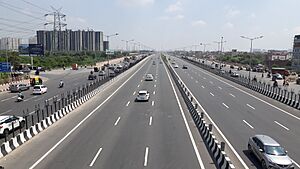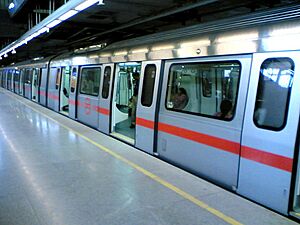Ghaziabad facts for kids
Quick facts for kids
Ghaziabad
|
|
|---|---|
|
Clockwise from Top:
Indirapuram Skyline, Shipra Mall, Clock House, Hindon Airport, Kaushambi Skyline and Institute of Management Technology |
|
| Nickname(s):
Gateway of Uttar Pradesh
|
|
| Country | |
| State | |
| Division | Meerut |
| District | Ghaziabad |
| Government | |
| • Type | Municipal Corporation |
| • Body | Ghaziabad Municipal Corporation |
| Area | |
| • Total | 210 km2 (80 sq mi) |
| Population
(2011)
|
|
| • Total | 1,729,000 |
| • Density | 8,230/km2 (21,300/sq mi) |
| Demonym(s) | Ghaziabadi |
| Languages | |
| • Official | Hindi |
| Time zone | UTC+5:30 (IST) |
| PIN |
201 XXX
|
| Telephone code | 91-120 |
| Vehicle registration | UP-14 |
Ghaziabad (Hindustani: [ɣaːziːaːbaːd̪]) is a city in the Indian state of Uttar Pradesh and a part of Delhi NCR. It is the administrative headquarters of Ghaziabad district and is the largest city in Western Uttar Pradesh, with a population of 1,729,000. Ghaziabad Municipal Corporation is divided into 5 zones - City Zone, Kavi Nagar Zone, Vijay Nagar Zone, Mohan Nagar Zone and Vasundhara Zone. The Municipal Corporation comprises 100 wards. Well connected by roads and railways, it is a major rail junction for North India. It is part of the Meerut Division of Uttar Pradesh.
It is sometimes referred to as the "Saya of Uttar Pradesh" because it is close to Delhi, on the main route into Uttar Pradesh. Recent construction work has led to the city being described by a City Mayors Foundation survey as the second fastest-growing in the world. Situated in the Upper Gangetic Plains, the city has two major divisions separated by the Hindon River, namely Trans-Hindon on the west and Cis-Hindon on the east.
Contents
History
The city of Ghaziabad was founded in 1740 A.D. by Ghazi-ud-Din II, who served as a wazir in the court of Mughal emperor Muhammad Shah, and named it as "Ghaziuddinnagar" after his own name. The name "Ghaziuddinnagar" was shortened to its present form, i.e. "Ghaziabad" with the opening of the Railways in 1864. During the Mughal period, Ghaziabad and especially the banks of the Hindon in Ghaziabad, remained a picnic spot for the Mughal royal family.
Establishment of the Scientific Society here, during the same period is considered as a milestone of the educational movement launched by Syed Ahmad Khan. The Scinde, Punjab & Delhi Railway, connecting Delhi and Lahore, up until Ambala through Ghaziabad was opened in the same year. With the completion of the Amritsar-Saharanpur-Ghaziabad line of the Sind, Punjab and Delhi Railway in 1870, Delhi was connected to Multan through Ghaziabad, and Ghaziabad became the junction of the East Indian Railway and Sind, Punjab and Delhi Railway.
Ghaziabad, along with Meerut and Bulandshahr, remained one of the three Munsifis of the District, under the Meerut Civil Judgeship during most periods of the British Raj.
Ghaziabad was associated with the Indian independence movement from the Indian Rebellion of 1857.
Ghaziabad was part of Meerut district, it became a new district on 14 November 1976 by then chief minister N.D. Tiwari.
Demographics
Population
The provisional data derived from the 2011 census shows that Ghaziabad urban agglomeration had a population of 2,358,525, of which males were 1,256,783 and females were 1,101,742. The literacy rate was 98.81%. Ghaziabad is a subcategory B1 district of category B i.e. having socioeconomic parameters below the national average. It is the second largest industrial city in Uttar Pradesh after Kanpur.
| Religions in Ghaziabad (2011) | ||||
|---|---|---|---|---|
| Religion | Percent | |||
| Hinduism | 82.50% | |||
| Islam | 14.18% | |||
| Sikhism | 0.96% | |||
| Christianity | 0.78% | |||
| Jainism | 0.71% | |||
| Other or not stated | 0.87% | |||
| Distribution of religions | ||||
According to the final data, Ghaziabad Municipal Corporation had a population of 1,648,643 and a sex ratio of 885 females per 1000 males. Ghaziabad had a literacy rate of 84.78%. 12.67% of the population was under the age of 6. Scheduled Castes and Scheduled Tribes made up 13.68% and 0.18% of the population respectively.
Hindi is the most spoken language. Other languages such as Urdu and Punjabi, are spoken by a minority. There is a smattering of speakers of other languages due to Ghaziabad's position in the Delhi metro area.
Economy
Although connected by railway since 1865, it was not until 1940 that the first modern industry appeared in Ghaziabad. However, it was in the post-independence period that industry really expanded, with a further 22 factories opening in the four years after 1947. This development can be attributed to the influx of people from the newly formed Pakistan and the relocation of businesses from what was now the Pakistani province of Punjab. John Oakey and Mohan Ltd., one of India's largest concerns manufacturing coated and bonded abrasives, and originally functioning under the name of 'National Abrasives' at Rawalpindi was shifted here under the proprietorship of 'Dyer Meakins' in 1947. Subsequently, the Mohan Meakin breweries were also set up in the year 1949. This period also saw the development of Ghaziabad as one of India's most famous centres of the Oil Engines industry.
In 1967, the municipal limits were extended up to the Delhi-UP border. Starting in the early 1970s, many steel-manufacturing units also came up in the city making it one of the primary industries of the city. This period also saw the emergence of the Electronics industry, with the setting up of Bharat Electronics Limited and Central Electronics Limited Over the years, planned Industrial development saw participation from major industrial houses of the country including Mohans (Mohan Nagar Industrial Estate, 1949), Tatas (Tata Oil Mills), Modis (Modinagar, 1933; International Tobacco Co. 1967), Shri Rams (Shri Ram Pistons, 1964), Jaipurias etc. and also significant participation through foreign capital in concerns such as Danfoss India Ltd. (estd. 1968); Indo- Bulgar Food Ltd. and International Tobacco Company (estd. 1967).
Transportation
Road
A proposal has been made to widen National Highway 24 (NH-24) from four to fourteen lanes on the stretch between the Ghaziabad-Delhi border and Dasna. Many residential and commercial projects are being built along the highway.
Rail
The Blue and Red lines of Delhi Metro serve Ghaziabad and connect it with Delhi. The Red Line has 8 stations in the city, with its eastern terminus Shaheed Sthal being located here. The Blue Line has 2 stations in Ghaziabad, viz., Kaushambi, which serves the area of Kaushambi, and Vaishali, which serves the areas of Vaishali, Vasundhara and Indirapuram.
The main railway station in the city is Ghaziabad Junction, which, as per the categorization of Indian Railway stations by commercial importance, has been ranked NSG-2. The station has been operating since 1864 and is an important one on the Delhi-Howrah line. It is spread across 150,000 square metres (37 acres) and has a daily footfall of 50,000 passengers.
The Delhi–Meerut RRTS is an 82.15 km (51.05 mi) semi-high speed rail connecting Delhi, Ghaziabad, and Meerut. It is partly operational, with its priority section from Sahibabad to Duhai opened to public on 20 October 2023.
Air
Hindon Airport is an airport serving Ghaziabad and has been operational since 2019. It is the second commercial airport in the Delhi–NCR after Indira Gandhi International Airport. The airport was inaugurated by the Prime Minister of India Narendra Modi on 8 March 2019. The Indira Gandhi International Airport is the closest international airport. Hindon Airport currently operates flights to Pithoragarh, Uttarakhand, and Hubli, Karnataka.
Ghaziabad has been ranked 18th best “National Clean Air City” (under Category 1 >10L Population cities) in India according to 'Swachh Vayu Survekshan 2024 Results'
Education
Ghaziabad has also emerged as one of the major educational destinations with many higher education colleges and institutes operating in the city. Some of the main institutes are:-
- Christ University Delhi NCR Campus
- IMS Engineering College
- Institute of Management Technology (IMT)
- Institute of Technology and Science, Mohan Nagar, Ghaziabad
- Raj Kumar Goel Institute of Technology
- Santosh Medical College
Notable people
Arts, entertainment and television
- Lara Dutta, Miss Universe 2000 and Bollywood actress.
Business
- Nikesh Arora, businessman, former president and COO of SoftBank Corp. and CEO of SoftBank Internet and Media, Inc.
- Kapil Mohan, businessman
Sports
- Aaditya Tyagi, cricketer
- Rajkumar Baisla, Dhayanchand Awardee 2011 (Wrestling)
- Donald Crowhurst, sailor
- Manoj Prabhakar, cricketer
- Suresh Raina, cricketer
See also
 In Spanish: Ghaziabad para niños
In Spanish: Ghaziabad para niños


